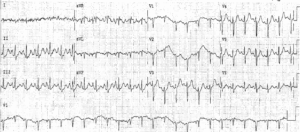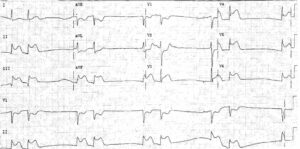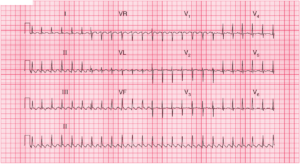ECG Interpretation
- Narrow complex tachycardia at 188/min
- No P waves visible
- Normal axis
- QRS complexes normal
- Some ST segment depression
Clinical interpretation
This ECG shows supraventricular tachycardia. This rhythm is usually due to a re-entry pathway within, or near to, the atrioventricular node, so the rhythm is properly called AV nodal re-entry tachycardia (AVNRT), although the term ‘supraventricular tachycardia’ is often (inappropriately) used.
The ST segment depression could indicate ischemia, but the ST segments are not horizontally depressed, nor is the depression greater than 2 mm, so it is probably of no significance, also with AVNRT there’s usually some ST depression.
What to do ?
The first action is carotid sinus pressure or valsalva maneuver, which may terminate the attack. If this fails it will almost certainly respond to adenosine.
As with any tachycardia, electrical cardioversion must be considered if there is haemodynamic compromise.
Once sinus rhythm has been restored, the patient must be taught the various methods (e.g. the Valsalva manoeuvre) with which she might try to terminate an attack.
Prophylactic medication may not be needed if attacks are infrequent, but most patients with this problem should have an electrophysiological study to try to identify a re-entry pathway that can be ablated.
- Read More: ECG Interpretation: All you need to know
- More Similar Cases:




